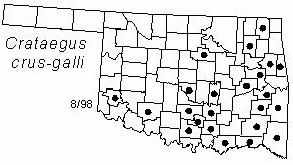Shrub or small tree to 6 m (20 ft) in height. Crown broad, irregular, open. Bark dark gray to brown. Twigs reddish brown when young, graying with age, glabrous, with many slender, brown spines up to 10 cm (4 in) long. Leaves alternate, simple, oblanceolate to narrowly elliptical, about 2.5 cm (1 in) long and 1.5 cm (0.6 in) wide; slightly thick and leathery, widest above the middle and tapering to a narrow base, short-pointed or rounded at apex, serrate above the middle with gland-tipped teeth; glabrous, dark green above, pale green below with raised veins; petiole 12-18 mm (0.5-0.75 in) long, stout and winged. Flowers in corymbs, glabrous, numerous, 13-15 mm (0.5-0.6 in) wide; calyx-tube narrow, obconic and glabrous; petals 5, white; styles 2-3, pink to pale yellow; stamens 10-20 in number; flowers appear from April to May. Fruits pomes, 10-13 mm (0.4-0.5 in) in diameter, subglobose or ovoid, greenish or dull red, thin, hard pulp; 2-3 nutlets, dorsally ridged. maturing by late Fall and persisting on the plant until early Spring.
Distribution: common throughout the eastern United States. Frequent to locally abundant throughout eastern Oklahoma.
Habitat: lowlands and upland openings. Also, fencerows and old-fields. It often forms dense thickets.
Comments: Crataegus is from the Greek meaning "flowering thorn"; crus-galli refers to the resemblance of the long spines to the spurs of a rooster.
Field identification: cockspur hawthorn has the longest spines of the Crataegus species in Oklahoma. Cockspur hawthorn very closely resembles barberry hawthorn (C. berberifolia). However, barberry hawthorn has pubescent stems and inflorescences.
Horticulture: cockspur hawthorn is widely planted because of its rounded crown and shiny leaves.
Wildlife benefits: In general, the fruits of hawthorn species are eaten by several species of birds. The dense branching pattern of cockspur hawthorn provides shelter and nesting habitat for several species of birds.
NWI status: FACU, FAC.
Distribution in Oklahoma: 
BACK
NEXT
RETURN TO INDEX
Last update: 9/9/99
 Go to Oklahoma Biological Survey Home Page
Go to Oklahoma Biological Survey Home Page
 Disclaimer
Disclaimer